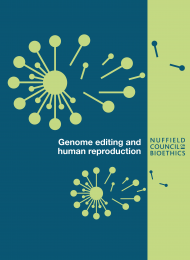Genome editing and human reproduction: social and ethical issues
Report
Published 17/07/2018

What is a genome?
The term ‘genome’ generally refers to the entire sequence of DNA of an organism. The genome includes sequences of DNA with specific functions that are involved in the production of the proteins and other molecules needed to carry out biological roles such as development, energy production, and fighting disease.
Genetic variation
Increasing understanding and knowledge of the human genome is complicating our understanding of states of ‘health’ and ‘disease’, and challenging the idea that a clear distinction can be drawn. There are many complexities in the relationship between genetic variation (differences in the DNA sequence that may lead to physiological differences between people), and health and disease, for example:
- all humans have a similar genome, although there are many small variations between the genomes of different people, making each person’s genome unique;
- some genetic variants are strongly associated with disease – many others predispose people to disease in certain circumstances;
- a particular genetic variant can be associated with different effects in different people;
- multiple genetic variants may interact with each other, and/or with environmental or lifestyle factors, to affect susceptibility or resistance to a particular disease in each of us;
- new genetic variants can arise spontaneously and, in some cases, these can be inherited (i.e. passed on to offspring); and
- sequencing of more people’s genomes is likely to reveal many new genetic variants associated with disease and other inherited characteristics.
What is genome editing?
Genome editing is the deliberate alteration of a selected DNA sequence in a living cell. Genome editing techniques can be used to alter how a gene functions, for example, by changing a variant of a gene that may give rise to disease to one that does not. As well as modifying the genome itself, the technique can be used to modify the epigenome – a set of chemical modifications associated with the genome that can control gene activity, e.g. changing gene expression without changing the DNA sequence.
CRISPR-Cas9 is an example of a relatively new method of genome editing that is now widely used in research. It is popular because of its relative efficiency, low cost, ease of use, and its potential to make edits at several sites in the genome in a single procedure.
Genome editing and human reproduction
Genome editing could potentially be applied in the context of assisted reproduction to alter a DNA sequence(s) of an embryo, or of a sperm or egg cell prior to fertilisation. The aim would be to influence the inherited characteristics of the resulting person.
We refer to these as ‘heritable genome editing interventions’ since the altered DNA may be passed to future generations.
One use of heritable genome editing interventions would be to have a child while excluding a particular heritable disorder that the child might have inherited from their biological parents. However, there are many complexities in the relationship between genomes and individuals’ wellbeing, so even if genome editing could ensure the child did not have the a genetic variant associated with a particular disorder, the ‘health’ of that future person could not be guaranteed.
Current use and availability
Genome editing is not currently available to people for reproductive purposes. Such procedures would be illegal in many countries, including the UK.
The science is comparatively new and would require further refinement before it could be used clinically. To date, a small number of research groups in China, the US and the UK have used genome editing techniques in human embryos grown briefly in laboratories, outside of the human body. These have not been used to create babies. More research is needed before we can establish whether any of the genome editing techniques developed to date would be an effective, safe, and viable approach in any particular circumstances.
Although it is lawful in the UK to create and use genome edited human embryos, sperm, or eggs in research, under strict licensing conditions, it would be illegal to use them in assisted reproduction. It would be necessary to change the law, which may require a long parliamentary process, before this could be permitted.
What approach did we take in this inquiry?
Our ethical analysis starts with prospective parents who may find themselves facing complex reproductive decisions, having access to certain new kinds of knowledge and information, and with a range of options that they might take, including those that biomedicine, economic affluence, and the moral endorsement of the society they live in have made available to them.
Perhaps the most obvious cases concern excluding inherited genetic disorders, but genome editing has the potential to be used for a wider range of purposes.
Our inquiry asks, therefore, in what circumstances, in what ways, and to what extent, should people be permitted, enabled, or assisted to pursue their reproductive goals?

Share